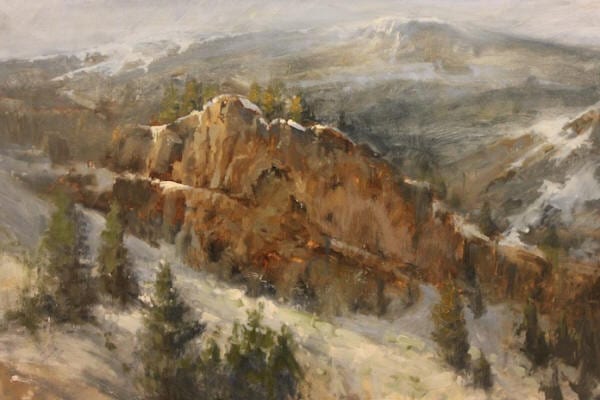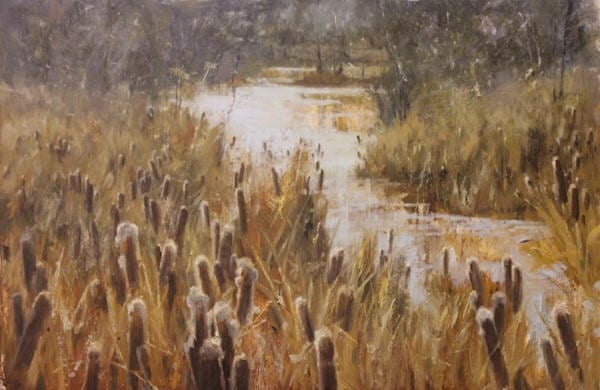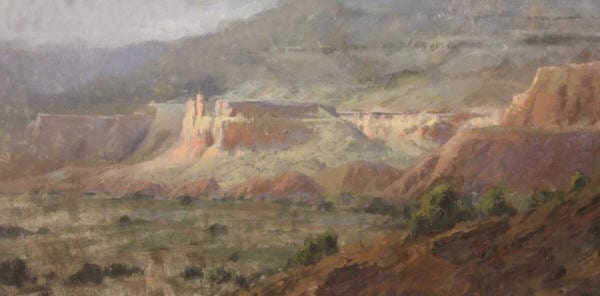The First of Three Elements of One Artist Goal Plan
By Roger Dale Brown, OPA
Artistic Goals, for me, are the most important of the three categories. It helps me to improve what I have to market, my art. Subcategories under these three elements help me compartmentalize specific areas I want to concentrate on. They are:
- Get better
- Painting from life and on location
- Seeing better as an artist
- Continue developing a critical eye
- Expanding my boundaries.
These will put my goals into action.
(1) Get Better:
 How do I get better? I acknowledge an area I am weak in and study that area. It is important for me to schedule time to do this. I am easily distracted with life situations and business. I also take advantage of an opportunity when it arises. I keep a drawing pad with me so I can draw anytime. Studying is not limited to painting. Drawing helps improve hand–eye coordination, seeing value and developing an intuitive response to my subject.
How do I get better? I acknowledge an area I am weak in and study that area. It is important for me to schedule time to do this. I am easily distracted with life situations and business. I also take advantage of an opportunity when it arises. I keep a drawing pad with me so I can draw anytime. Studying is not limited to painting. Drawing helps improve hand–eye coordination, seeing value and developing an intuitive response to my subject.
I also adhere to the theory of frequency, intensity and duration. If you do something often, you will get better at it. If you study with intensity there is a higher chance of retaining what you study. The longer you work on something, the more likely your task will become intuitive.
It coincides with a quote I read in my classes:
“Nothing in this world can take the place of persistence. Talent will not; nothing is more common than unsuccessful people with talent. Genius will not; unrewarded genius is almost a proverb. Education will not; the world is full of educated derelicts. Persistence and determination alone are omnipotent. The slogan ‘press on’ has solved and always will solve the problems of the human race.”
– Calvin Coolidge
(2) Painting from Life and on Location:
 I decide how many on location or from life study paintings I want to paint that year. I schedule the time as much as possible but many times it is spur of the moment. Realize that every painting is not started with the idea that it is going to be a finished masterpiece. Most of the time I paint on location to study. I can read, study, take workshops every month, but if I don’t put theory to the test I will not grow. Most times I paint from life with the intention of studying a specific problem area or theory, not to create a masterpiece. Paint with a plan!
I decide how many on location or from life study paintings I want to paint that year. I schedule the time as much as possible but many times it is spur of the moment. Realize that every painting is not started with the idea that it is going to be a finished masterpiece. Most of the time I paint on location to study. I can read, study, take workshops every month, but if I don’t put theory to the test I will not grow. Most times I paint from life with the intention of studying a specific problem area or theory, not to create a masterpiece. Paint with a plan!
(3) Seeing Better As An Artist:
 Before I touch my canvas, I try to see the subject in its’ simplest form or as an abstract. Then I mentally build the scene back up and visualize the end result of my painting. I have discovered when I visualize the end result of my painting, the likely hood of succeeding increases.
Before I touch my canvas, I try to see the subject in its’ simplest form or as an abstract. Then I mentally build the scene back up and visualize the end result of my painting. I have discovered when I visualize the end result of my painting, the likely hood of succeeding increases.
Sometimes I leave my paints at home and observe how light falls over a subject, how things reflect off each other. I look through the detail and see large simple shapes or masses, the value of those masses, patterns of light and color within those masses and all the other nuances. I simply practice seeing and remembering.
The ability to “see as an artist sees” is one of the most important elements of learning and developing. Cicero once said, “Art is born of the observation and investigation of nature”.
(4) Continue Developing a Critical Eye:
 It is very important to become a student of art, to develop a critical eye. I have collected a library of art books, I look at magazines and visit museums whenever possible to study. Having a group to critique each other’s work regularly is also very helpful to start understanding what makes a good painting. To know a good painting when you see one, you also have to see the mistakes. The old masters, contemporary masters and our piers make mistakes. It’s just as important to see what they did wrong as it is to see what they did right.
It is very important to become a student of art, to develop a critical eye. I have collected a library of art books, I look at magazines and visit museums whenever possible to study. Having a group to critique each other’s work regularly is also very helpful to start understanding what makes a good painting. To know a good painting when you see one, you also have to see the mistakes. The old masters, contemporary masters and our piers make mistakes. It’s just as important to see what they did wrong as it is to see what they did right.
Frank Dumond told his students: “I am not here to teach you how to paint, I am here to teach you how to see”. He did not just mean seeing the subject your painting and the nuances within but also the ability to know what a good painting looks like. By developing a critical eye you will develop the ability to critique your own work intelligently and then you can take the necessary steps to correct the problems.
(5) Expanding My Boundaries:
 I put a lot of importance on being a well-rounded artist. My passion is landscape panting. I love the outdoors and the beauty of nature. But, I also like other subjects and I know that one of the ways for me to grow is to be diverse in what I paint. I also venture to try new techniques, new mediums and tools and I even make tools and equipment to help in certain situations. At the end of the day I always bring something new back to my art.
I put a lot of importance on being a well-rounded artist. My passion is landscape panting. I love the outdoors and the beauty of nature. But, I also like other subjects and I know that one of the ways for me to grow is to be diverse in what I paint. I also venture to try new techniques, new mediums and tools and I even make tools and equipment to help in certain situations. At the end of the day I always bring something new back to my art.
The idea of being a well-rounded painter has been important to the masters for centuries. In 1901, John Singer Sargent wrote about it in a letter to a student.
“You say you are studying to become a portrait painter and I think you’d be making a great mistake if you kept that only in view during the time you intend to work in a life class, for the object of the student should be to acquire sufficient command over his materials and do whatever nature presents him. The conventionalities of portrait painting are only tolerable in one who is a good painter. If he is only a good portrait painter, he is nobody. Try to become a painter first and then apply your knowledge to a special branch or you will become a mannerist.”
Dot Courson says
Roger Dale Brown is a true artist and southern gentleman whose humble voice resonates with every artist and student who truly loves and desires to improve. Still waters run deep -and this is true so with Roger and his dedication to his life’s work.
New students meeting him for the first time are at once aware of his wisdom and his sincere dedication to them and to his craft. Truly blessed to be able to call him my friend, mentor and encourager!
Susan Patton says
Roger- This is Susan Patton. Thank you for this blog. I will always remember and be encouraged by your interest and encouragement to me during your workshop in my “early” artist years. I walked out of the door of your workshop a different person- a student- a life-long student of what is “good” in art. I am still learning, and now teaching others. One thing that inspired me from your teaching was to set goals. I set them last year, and will do so again this year. Thank you for your belief in me!
joyce snyder says
If only we could sit at your feet and learn Roger Dale Brown. These words are gems. They rattle your conscience…you can’t get away from these truths. Thank you for sharing and I wish I could copy and keep these wise words. Thanks
Ellen Walton says
Your words are truly an inspiration for me and anyone else reading your article and seeing your gorgeous paintings. Love your idea about having a plan for your painting and visualizing the end result. Also, like your words on acknowledging the areas that one is weak in and studying those areas. Looking forward to reading your next two articles and seeing more of your beautiful paintings. Thank ou!
Zel Ilano says
Excellent commentary – I was enlightened by the points – Does anyone know if my business can get a sample IRS 1040 – Schedule E version to fill out ?